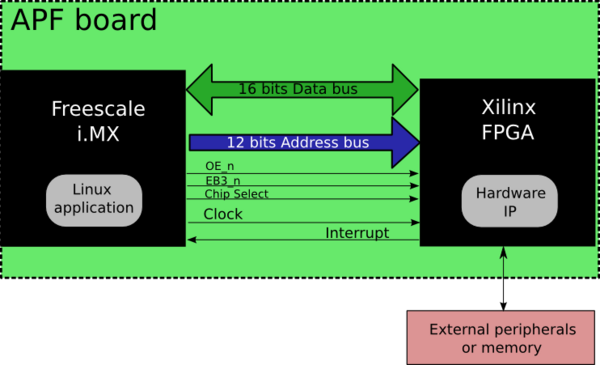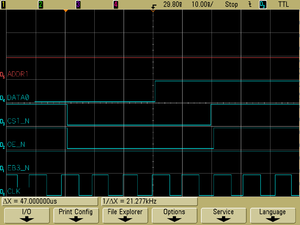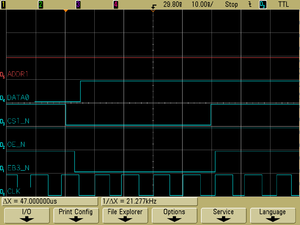FPGA
Contents
FPGA on the APF boards
The APF boards are equipped with a Xilinx Spartan FPGA (Field Programmable Gate Array). A FPGA is a configurable digital device. Today, large and complex digital circuits and processor cores can fit into FPGAs. To find more informations about FPGAs, check this Wikipedia article
The FPGA on the APF is connected to the i.MX processor busses (data & address) and to the APF Hirose connectors. This makes it possible to design your own peripherals and to put them into the FPGA. Because the FPGA can be reconfigured at any time, it allows you to replace these peripherals (or a part of them) in-situ (if other functionalities are needed, for example). This is even possible at run-time !
To use custom «virtual» devices, there is a tool named Peripherals On Demand, developped by ARMadeus, that simplify FGPA-device and Linux driver integration.
FPGA Firmware Development
Digital Hardware Design
FPGAs are quite complex digital devices. Modern tools allow to describe the circuits to be implemented an abstract way, which makes it possible to manage the complexity. The trend for new tools is toward higher levels of abstraction in order to be able to manage even more complex devices in future. Nevertheless, at least basic knowledge of digital circuits and gates is necessary to start designing firmware for FPGAs.
FPGA Design-Flow
The starting point for the implementation flow is a description of the functionality in a Hardware Description Language (HDL). One of the most commonly used HDLs is VHDL (Very High Speed Integrated Circuit Hardware Description Language). VHDL files are plain text files and editing can be done with any editor.
This VHDL circuit description can be simulated to verify the functionality.
If everything is working fine, a tool called synthesizer is used to translate this HDL description into a hardware netlist. Then this netlist is mapped onto the FPGA technology. After Place and Route and Bitstream generation, a configuration file for the FPGA is created (bitfile).
For more informations about VHDL and the design flow, see [1]. This page also contains many examples that show how to describe simple electronic circuits in VHDL.
Armadeus Firmware Development Environment
Development Software
Synthesis
For FPGA development, you need the Xilinx ISE WebPack from Xilinx. It can be downloaded for free (after registration) from the Xilinx webpage. The WebPack contains all you need to implement a design for the FPGA on the APF: Editor, Synthesizer, Mapper, Place and Route Tool, Bitstream generator, and the tools to download a configuration to the FPGA. ISE WebPack is available for Windows and Linux. See the ISE WebPack installation on Linux page for more infos.
Simulation
For simulation, Xilinx offers a free version of ModelSim, called ModelSim Xilinx Edition (MXE). It can also be downloaded from the Xilinx homepage [2] for free, but registration is required in order to receive a license. MXE is available for Windows only. The alternative for Linux users is GHDL. More information can be found on the VHDL for Linux page.
VHDL code editor
The editor in ISE is not very useful and convenient. In principle, any alternative editor can be used with ISE, but some have special support for VHDL-Code as syntax highlighting, template insertion, indenting and many other cool features that help to write nice and error-free code in less time. The VHDL Mode for the well known GNU Emacs editor can be recommended in particular. Emacs is available for all important operating systems.
Design Implementation
Implement your design with the ISE WebPack software. If you are new to VHDL, these informations can give you a first idea. Tutorials for the ISE software can also be downloaded from the Xilinx webpage.
Bitstream generation
When your design is ready and passes the simulation, you can create a bitstream file that can be downloaded to the FPGA. It contains all the data to configure the FPGA.
In the ISE Project Manager, make sure that a Binary Configuration File is also created. You can set this option in the properties dialog of the Generate Programming file process. Activate the option Create Binary Configuration File.
The file with the ending .bin is now the file you need to configure the FPGA on the Armadeus module.
Licence
The firmware for the FPGA has to be licenced under LGPL and BSD.
Please add to each created file a header containing the name of the "company" here it is an association, the maintainer name, the licence.
If a part of a work of an other developper has been reused, please indicate where this part has been found, the author name and keep the original licence. If no licence is specified, assume it is unlicenced.
Configuring the FPGA on your APF board
From U-Boot
From Linux
FPGA i.MX bus timing diagrams
The following timings diagrams have been taken with an Armadeus release 2.1


